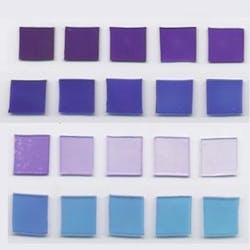IMAGE: University College London (UCL) has developed an antimicrobial suface using various dyes and nanoparticles that can kill harmful pathogens both under a normal fluorescent bulb and incredibly, in the dark as well. (Image credit: UCL)
University College London (UCL; London, England) researchers have developed a new antibacterial material that has potential for cutting hospital-acquired infections. The combination of two simple dyes with nanoscopic particles of gold is deadly to bacteria when activated by light--even under modest indoor lighting. And in a first for this type of substance, it also shows impressive antibacterial properties in total darkness.
RELATED ARTICLE: Laser technique modifies surfaces to prevent the spread of bacteria
The research is published in a Chemical Science paper. Hospital-acquired infections are a major issue for modern medicine, with pathogens like methicillin-resistant Staphylococcus aureus (MRSA) and Clostridium difficile (C. diff) getting extensive publicity. Although medical establishments have stringent cleaning policies, insist on frequent hand-washing by staff, and have powerful drugs at their disposal, it is difficult to eliminate these infections unless you can make the hospital environment more hostile to microbes.
One possible solution to this is to develop alternative strategies such as antibacterial coatings that make surfaces less accommodating to germs. These surfaces are not like antibacterial fluids that just wash away--the goal is to make a surface which is intrinsically deadly to harmful bacteria.
"There are certain dyes that are known to be harmful to bacteria when subjected to bright light," explains the study's corresponding author Ivan Parkin (Head of UCL Chemistry). "The light excites electrons in them, promoting the dye molecules to an excited triplet state and ultimately produces highly reactive oxygen radicals that damage bacteria cell walls. Our project tested new combinations of these dyes along with gold nanoparticles, and simplified ways of treating surfaces which could make the technology easier and cheaper to roll out."
The team tested several different combinations of the dyes crystal violet (already used to treat staph infections), methylene blue and nanogold, deposited on the surface of silicone. This flexible rubbery substance is widely used as a sealant, a coating and to build medical apparatus such as tubes, catheters and gaskets, and can also be used as protective casings for things like keyboards and telephones.
While work to create antimicrobial surfaces in the past has often concentrated on complex ways of bonding dyes to the surface, this study took a simpler approach. The researchers used an organic solvent to swell the silicone, allowing the methylene blue and gold nanoparticles to diffuse through the polymer. They then dipped the silicone into a crystal violet solution to form a thin dye layer at the polymer surface.
In their tests, in which infected surfaces were subjected to light levels similar to those measured in hospital buildings, surfaces treated with a combination of crystal violet, methylene blue and nanogold showed the most potent bactericidal effect ever observed in such a surface. Moreover, the treatment did not significantly change the properties of the silicone (for instance, how water repellent it is), and the coating was not affected by rubbing with alcohol wipes, meaning it can stand up to the repeated cleaning that goes on in hospitals, without being worn off.
"Despite contaminating the surface with far more bacteria than you would ever see in a hospital setting, placed under a normal fluorescent light bulb, the entire sample was dead in three to six hours, depending on the type of bacteria," says the paper's lead author, Sacha Noimark. "That was an excellent result, but the bigger surprise was the sample which we left in the dark. That sample too showed significant reductions in bacterial load, albeit over longer timescales of about three to eighteen hours. The precise mechanism by which this dark-kill works is not yet clear, though."
This is the first time a light-activated antimicrobial surface has had any kind of effect in the dark. This, along with its unprecedented performance under hospital lighting conditions, and relatively simple and cost-effective manufacture, means that the technology is extremely promising for future applications.
The team was granted a patent on the formulation. The work was sponsored through the UCL M3S engineering doctorate centre and co-funded by Ondine Biopharma.
SOURCE: University College London; https://www.ucl.ac.uk/news/news-articles/0314/240314-antimicrobial-surface
